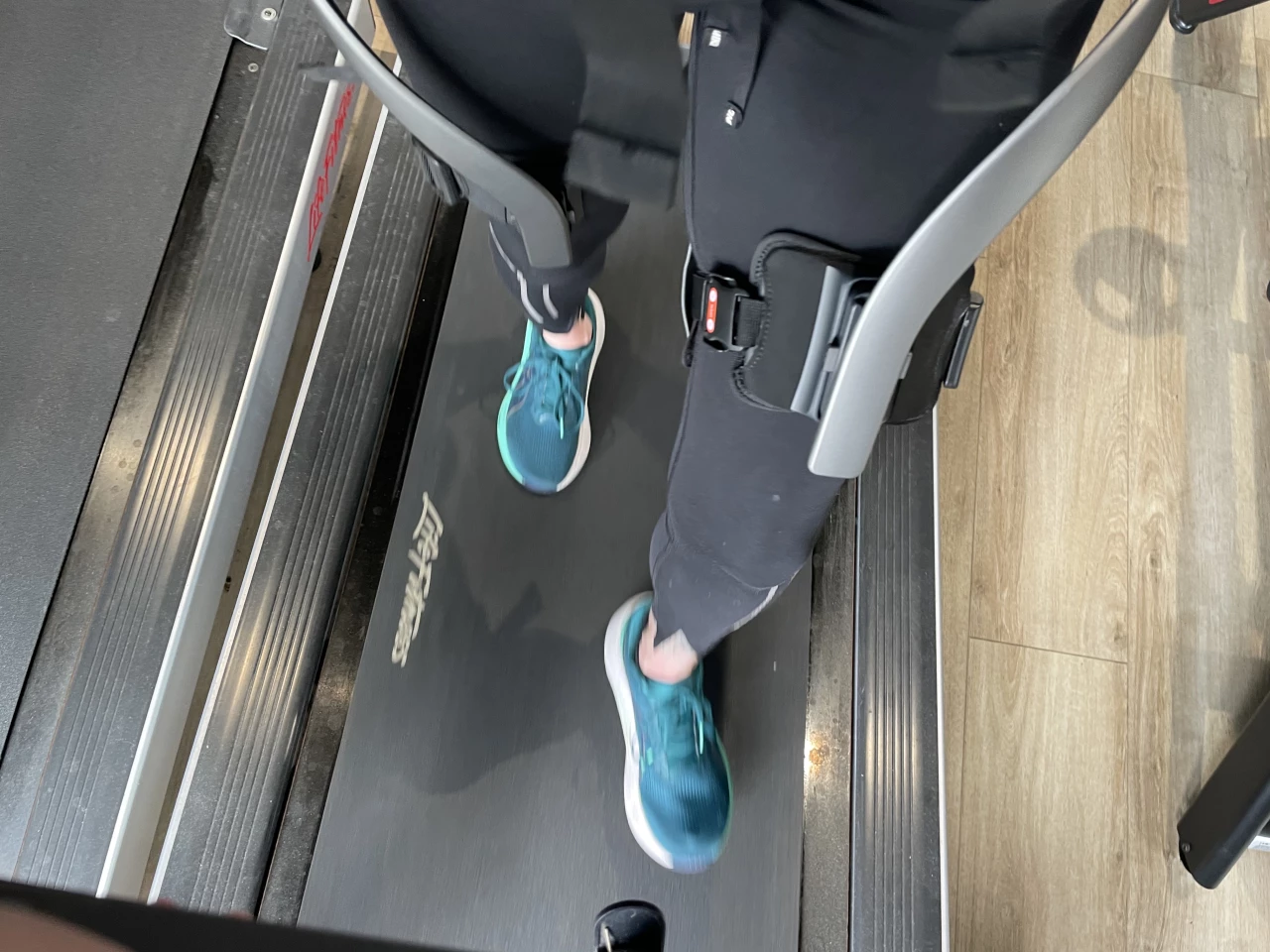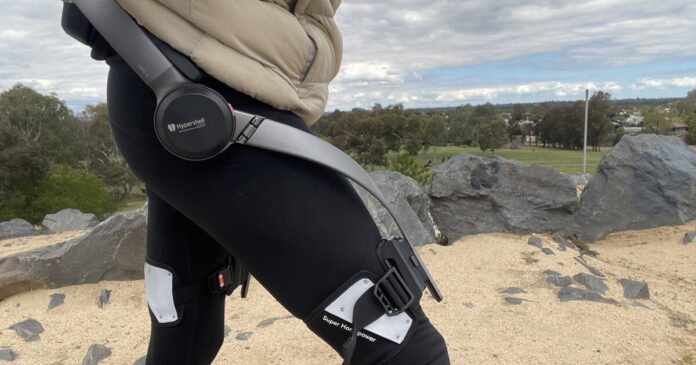The Hypershell Pro X exoskeleton might be the closest we’ll get – in this age, at least – to being able to instantly tap into a type of superpower, and once you’ve experienced it, it’s hard to go back to just using the legs nature gave you to.
At first glance, the Hypershell Pro X looks like high-end hiking gear, but the moment you strap in and turn it on, you see that it’s technology built for a future where hiking harder, running longer distances or carrying heavier loads doesn’t mean putting in the work to manage it on your own.
The Pro X is an AI-powered exoskeleton with an 800-watt output, 10 different modes – walking, race walking, uphill, downhill, up/down stairs, gravel hiking, cycling, running and mountain trekking – and a sturdy but lightweight frame at 4.4 lb (2 kg), excluding battery.
Hypershell
Unpacking it from the handy carry case it comes packed in, the exoskeleton looks slightly intimidating, however once you strap yourself in, the accompanying app walks you through adjusting the equipment for your build and height, to ensure a comfortable fit. Hypershell says it should fit around 80% of people, and at about 5ft5 (169 cm) and with a reasonably slim build, it was never going to be an issue with me. You do feel the weight of it when strapped in, so it’s important the hip joints are properly adjusted. Then, excellent padding on the back of the Pro X, which also houses the removable battery, provides great support. Overall, it doesn’t feel at all as cumbersome on as it appears it might be when you’re holding it out of the box.
Now, I have to admit, I was maybe even more intimidated by using the Pro X. As someone who has been running, kickboxing and cycling regularly for decades, my natural limbs seemed a little resistant to hand over some control to this foreign contraption that promised to assist in a range of movements. And at first the exoskeleton does feel quite alien, even though it’s incredibly comfortable and not all all restrictive. At first you can expect to walk in a slightly exaggerated way – a little like a half-robot marionette – until you get more of a hang of it (and a hang of the settings and intensity).
The app (iOS, Android) allows you to override the AI activity sensor and choose just one mode – cycling, for example – but I found it was intuitive enough to switch between running and walking, uphill and walking, and cycling and walking the bike that it becomes easier to put the phone away and control everything from the Pro X itself. That said, everything on the model is controlled by a single button, and different LED colors and dots represent modes and levels. The sensor’s 2-ms response time ends up being faster than manually switching between activities on the app, too.
Unlike some apps paired with devices and gadgets, the interface and control on this one are exceptional, and it offers extra metrics like battery, speed and distance, plus easy updates to firmware (however, you’ll need to be strapped into the exoskeleton for the updates to come through).

New Atlas
The modes are Eco, Hyper and Transparent, and it does take a bit of learning to hit the right button combination to switch between them – I kept double tapping, which instead increased intensity by a level each time. Eco mode offers a gentle support for more everyday activities like walking or covering slight inclines, while Hyper definitely takes things up a notch for running or steeper climbs. The higher the level of support, the trickier it is to walk ‘normally’ – which is why it’s best to then switch into Transparent, which pauses the power to let you take all the control back. Overall, the Pro X offers up to 32 Nm (23.6 lb.ft) of torque – but you won’t be pushing it to its limit often – and delivers 12.4 mph (20 km/h) speed assistance.
The makers claim that the Pro X helps to redistribute weight and effort in order to reduce strain on knees, hips and ankles, especially when carrying a load. I definitely felt the help going up steeper inclines, which I could even switch into a run and cover pretty easily without the usual exertion. However, running or walking at pace at an incline on a treadmill didn’t necessarily change how much effort my body was putting into the movement – if heart rate is anything to go by. That said, I’m very active, running up to 15 miles (24 km) and walking a good 50 miles (80 km) a week, so it may benefit someone with less endurance power more. It did, however, seem to improve my posture when activated, keeping my lower back braced in position better than my clearly not-great natural mode – and this helped to feel like the exoskeleton was supporting me, more than me carrying it along.

New Atlas
And it does seem to lighten the load on joints. I have a temperamental ankle due to a triple break a few years back, and the Pro X certainly feels like it’s taking some of the pressure of it when undertaking lengthy repetitive movements. The exoskeleton pulls your legs up, which creates momentum, but you’ll certainly still feel a workout in your hamstrings on lengthy inclines. Hypershell claims the Pro X offsets 66 lb (30 kg) of weight, though it’s a little less in reality given the extra load of the device itself.
When not in use, the exoskeleton folds down to around 16.9 x 10.2 x 4.9 in (430 x 260 x 125 mm). It won’t slip into small backpacks, but it could squeeze into my medium-sized everyday pack without too much trouble. Which means it’s also fine for airline cabin bags, if you don’t want to port it around in its own carry case. One issue, though, is that if you don’t have a dedicated charging station, you’ll need to plug the USB-C cable into the whole exoskeleton, not just the battery. So even if you have swappable batteries, you’ll need to have both charged up on the device before packing the spare in your bag for later.

Hypershell
Speaking of batteries, the Pro X promises 800 W of power over 10.1 miles (17.5 km) per charge, but there’s a lot of variability in that depending on what mode you’re using. After a few hours, the battery loses about a third of its charge, so you’d want a backup unit if you’re planning on using it for more than about 8 miles (13 km). Hyper mode is a lot of fun, but will drain the battery fastest, so Eco should be the go-to mode for endurance. Charging to full from flat also takes some time – around 88 minutes – so a backup battery is recommended.
Now, the padding will get sweaty if you’re hiking hard or in warm weather (not an issue in Melbourne, Australia during spring). The padding is removable for washing, however, and the material is easy to wipe down. It does restrict access to pants and jacket pockets, and might feel a bit awkward wearing with a backpack that sits lower than the top of the hips, so bear that in mind. The frame itself is sturdy but not obtrusive, made of carbon fiber reinforced polymer, aluminum alloy and stainless steel.
While the technology is still emerging, if you’ve been curious about an exoskeleton then the Pro X is a good model to jump in on. If you’re like me and have a pretty high level of aerobic fitness and leg strength, you may appreciate the assistance but not get as much out of it as you would if you had any mobility issues (online reviews suggest it’s been excellent for improving movement and how far people can walk without needing an aid such as a walking stick). The makers claim it offers 40% more leg strength, but this obviously varies based on activity and physical fitness. While I didn’t test for it, it feels like it would also be a handy assistance tool for injury rehabilitation – though you’d best to take your physiotherapist’s, not my, advice on that.
Overall, the Hypershell Pro X is a robust hill-flattener for early adopters – and it offers a credible glimpse of where outdoor exoskeletons are heading. The model comes with two batteries, charging cable, carry case and clear user manual, and is available for US$1,099.
Source: Hypershell
Note: New Atlas may receive a commission from purchases made via links; this does not influence our review. Our reviews are impartial and our opinions are our own.


